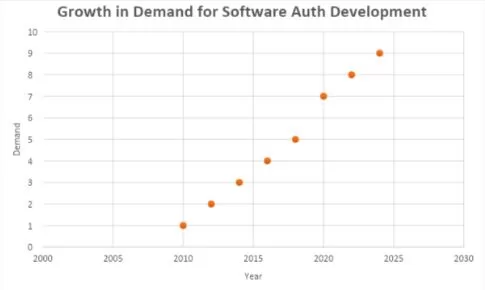Share post on
Introduction
Software auth development is crucial for modern applications. Effective software auth development ensures secure user access and authentication processes. The demand for software auth development continues to grow as more businesses seek reliable solutions. With software auth development, companies can protect sensitive data and enhance user trust.
In today’s digital landscape, many businesses are turning to custom web applications to meet their unique operational needs. Investing in software auth development within custom web applications is essential for maintaining robust security. Efficient software auth development helps streamline user management, reduces vulnerabilities, and enhances the security of custom web applications.
Embracing software auth development in custom web applications allows businesses to stay ahead in the evolving tech field. With the increasing prevalence of cyber threats, securing sensitive information within custom web applications and ensuring only authorized users access critical resources has become more vital than ever. Authentication and authorisation are central to any custom web application’s security framework, each playing a distinct role in protecting systems from unauthorised access.
Table of Contents
Key Differences Between Authentication and Authorization
Although authentication and authorization are closely related, they serve different purposes. Here’s a summary of their key differences:
| Aspect | Authentication | Authorization |
|---|---|---|
| Definition | Process of verifying the identity of a user. | Process of determining what an authenticated user can access or do. |
| Purpose | To ensure that the user is who they claim to be. | To control access and permissions for resources and actions. |
| Credentials | Usernames, passwords, biometrics, security tokens. | Roles, permissions, attributes, policies. |
| Process | User provides credentials (e.g., password, biometric data). | System checks user permissions after successful authentication. |
| Outcome | Successful login or access to the system. | Access is granted or denied based on permissions. |
| Primary Security Control | Verifying user identity. | Controlling access and ensuring authorized actions. |
| Methods |
- Password-based authentication - Multi-factor authentication (MFA) - Biometric authentication (ABA) - OAuth2 for API authentication - Passwordless authentication |
- Role-Based Access Control (RBAC) - Attribute-Based Access Control (ABAC) - Context-Aware Authorization - Permission Auditing |
| User Interaction | Typically involves entering credentials or providing biometric data. | Involves accessing resources or performing actions based on permissions. |
| Example | A user logs in with a username and password. | An authenticated user can view, edit, or delete specific files based on their role. |
| Implementation Strategy |
- Enforce strong password policies - Implement MFA - Use OAuth2 - Introduce biometric authentication - Implement passwordless options |
- Define user roles and permissions - Apply RBAC policies - Implement context-aware access controls - Conduct regular permission audits |
| Challenges |
- Ensuring secure storage of credentials - Preventing phishing attacks - Managing password fatigue |
- Managing complex permission structures - Handling changes in roles or permissions - Integrating with legacy systems |
| Future Trends |
- Integrating with existing systems - AI and ML for enhanced authentication - Increasing adoption of biometric methods - Growth of passwordless authentication |
- Preventing privilege escalation - Zero-trust architecture - Fine-grained attribute-based controls - Advanced context-aware authorization techniques |
| Compliance | Helps meet basic security standards and regulations. | Critical for compliance with privacy regulations (e.g., GDPR) and data protection laws. |
Importance in Modern Software
Protecting Sensitive Data
The primary purpose of authentication and authorization is to protect sensitive data from unauthorized access. Whether it’s personal information, financial records, or proprietary company data, ensuring that only authorized users can access this information is vital for maintaining privacy and security.
Compliance with Regulations
Many industries are subject to strict regulations regarding data protection and privacy. For example, the General Data Protection Regulation (GDPR) in Europe imposes stringent requirements on how personal data is handled. Implementing robust authentication and authorization mechanisms is often necessary to comply with these regulations and avoid severe penalties.
Mitigating Insider Threats
Not all threats come from external sources. Insider threats—where employees or other trusted individuals misuse their access to sensitive information—are a significant concern for many organizations. By implementing granular authorization controls, companies can limit the potential damage caused by insider threats by ensuring that users only have access to the information necessary for their role.
Enhancing User Trust
Users are more likely to trust a system that they know is secure. Implementing strong authentication and authorization processes can enhance user trust by demonstrating a commitment to protecting their data and ensuring that only authorized individuals have access to it.
Growth in Demand for Software Auth Development
The graph illustrates the growth in demand for software authentication (auth) development over time. The steady increase in the graph highlights the rising importance of secure authentication and authorization processes in modern applications.

Disclaimer: The data presented in this graph is illustrative and does not represent actual statistical data. However, the trend shown is based on the generally accepted understanding of the growing importance of software authentication (auth) development in the industry. The graph is intended to visually represent the increasing relevance of secure authentication and authorization processes over time.
Implementation Strategies
Implementing effective authentication and authorization requires careful planning and adherence to best practices. Here are some strategies for both processes:
For Authentication
Multi-Factor Authentication (MFA)
Adds an extra layer of security beyond just a password. Requires users to provide two or more verification factors—such as a password and a one-time code sent to their mobile device. Reduces the risk of unauthorized access, even if one factor is compromised.
OAuth2 for API Authentication
Securely authenticate users for web and mobile applications. OAuth2 allows third-party services to exchange tokens on behalf of users without exposing their credentials. Enhances security and user experience by allowing single sign-on (SSO) capabilities.
Biometric Authentication
Uses physical characteristics like fingerprints or facial recognition for authentication. Leverages devices with biometric sensors (e.g., smartphones) to verify identity. Provides a higher level of security and convenience compared to traditional passwords.
Passwordless Authentication
Eliminates the need for traditional passwords. Utilizes methods like magic links, biometrics, or hardware tokens. Reduces the risk of password-related attacks and improves user experience
For Authentication
Role-Based Access Control (RBAC)
Manages permissions based on user roles. Defines roles (e.g., admin, editor, viewer) and assigns permissions to each role. Simplifies the management of user permissions and reduces the risk of unauthorized access.
Attribute-Based Access Control (ABAC)
Provides fine-grained access control based on user attributes. Evaluates attributes such as department, location, and time of access to make authorization decisions. Offers more flexibility and security than RBAC by considering multiple factors.
Context-Aware Authorization
Makes real-time access decisions based on the context. Analyzes factors such as device type, location, and behavior patterns before granting access. Enhances security by adapting authorization decisions to the current context.
Permission Auditing
Regularly reviews and updates user permissions. Conducts audits to ensure that permissions align with current user roles and responsibilities. Prevents privilege creep and ensures that users have only the necessary access.
Balancing Security and User Experience
Common Challenges
Despite the importance of authentication and authorization, developers often face several challenges when implementing these security measures:
Balancing Security and User Experience
Users demand seamless and convenient access, while security measures often require additional steps. Implementing user-friendly security measures like MFA, SSO, and biometric authentication can help strike the right balance.
Managing Roles and Permissions
In large organizations, managing roles and permissions can become complex, especially when dealing with changes in staff or organizational structure. Utilizing automation tools to streamline role and permission management and conducting regular audits are effective strategies.
Integrating with Legacy Systems
Older systems may not support modern authentication methods, posing challenges in maintaining security standards. Implementing middleware or API gateways can bridge the gap between legacy systems and modern authentication solutions.
Preventing Over-Privileged Accounts
Users may accumulate excessive privileges over time, leading to security risks. Regularly reviewing user permissions and implementing the principle of least privilege can minimize these risks.
Future Trends
Conclusion
software auth development ensures that applications have secure and reliable authentication mechanisms. The role of software auth development has become increasingly important as the need for robust security grows. By focusing on software auth development, businesses can effectively safeguard user information. Investing in software auth development not only enhances security but also improves the user experience. High-quality software auth development practices lead to better protection against unauthorised access. As technology evolves, software auth development remains a key area of focus. Embracing software auth development is essential for maintaining security and efficiency in any digital environment
Share post on



